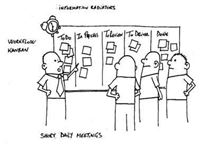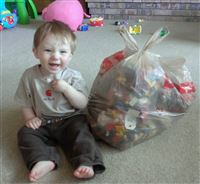 About a year or so ago, the pastor of our church (Pastor Weiser), announced that he would be going into semi-retirement this summer. Instead of just retiring like most people his age, he’s taking a half-time job as our missionary in Nigeria. He’ll spend quite a few months out of each year over there helping to train new Nigerian pastors. It’s always been one of his passions and he’s spent a lot of time there over the decades. I’m excited for him, but that leaves us without a Pastor.
About a year or so ago, the pastor of our church (Pastor Weiser), announced that he would be going into semi-retirement this summer. Instead of just retiring like most people his age, he’s taking a half-time job as our missionary in Nigeria. He’ll spend quite a few months out of each year over there helping to train new Nigerian pastors. It’s always been one of his passions and he’s spent a lot of time there over the decades. I’m excited for him, but that leaves us without a Pastor.
I’ve heard a few comments/questions that can generally be summarized to “What happens if you don’t agree with what your new Pastor teaches?” I’m very thankful and happy to say that there is almost no chance that this will happen and I’ll explain why in this post.
Our local church, Calvary Lutheran Church, is part of a bigger group called the Wisconsin Evangelical Lutheran Synod or WELS for short. The WELS is the central body that oversees all the churches to make sure we all teach exactly the same thing. While the types of church buildings and the styles of the church services might change from one WELS church to another, I can walk into any one of them and know that they are teaching exactly what the Bible says.
So when our Pastor left, we went put out a “call” for a new pastor. I won’t dive into the details of what a call is and why we do it because the WELS website already has a good description of that. I’ll just briefly say that the process is based on the Bible’s teachings and it’s not like a normal job interview. We ended up getting a Pastor who was just graduating from the WELS seminary. This will be his very first congregation.
Getting back to the original question, even though he’s never led a congregation before, I’m confident that he’ll stay true to God’s Word. His schooling included four years at our teacher/pastor training school (Martin Luther College) and then an additional four years at our seminary (Wisconsin Lutheran Seminary.) He’s well-versed in all of the Bible’s theology and he knows the original languages that it was written in (Greek and Hebrew) so that he can always go back to the most original manuscripts when needed.
But hey, everyone is human and we all sin. All of this training and process doesn’t mean that every single pastor is always right on target. Thankfully there are lots of checks and balances in place. First of all, every single person in the church should be actively listening and testing the words that the Pastor preaches. The book of 1 John teaches us to “test the spirits.” We should be comparing everything the Pastor teaches to what the Bible teaches. If they don’t align, we should investigate and question until the issue is resolved. In the worst case, this could be escalated all the way to the synod body which could take action to remove a Pastor from the synod entirely.
This is quite a bit more rigid and strict than many other church bodies, but that is what has kept our group of churches so rock solid on the teachings of the Bible. I’m very thankful that when I move to a new area or go on vacation, I don’t have to search around for a church. I just pull up the WELS directory, find a convenient location and start attending.

 I’ve never worked on a team that really used an agile process. Some claimed they did but they only went so far as to use it as an excuse to not plan. This new team follows a variation on Kanban that is being developed by another manager in our org, Brent. It’s spreading pretty quickly and I wouldn’t be surprised if there was a book written about it in the future.
I’ve never worked on a team that really used an agile process. Some claimed they did but they only went so far as to use it as an excuse to not plan. This new team follows a variation on Kanban that is being developed by another manager in our org, Brent. It’s spreading pretty quickly and I wouldn’t be surprised if there was a book written about it in the future. Happy Fourth! Here are some fun trivia facts to annoy your friends and family:
Happy Fourth! Here are some fun trivia facts to annoy your friends and family: Yes, I know the plural of Lego is Lego, but in my world, the plural is Legos. Deal with it. The other way sounds too pretentious. It’s like calling that fancy sports car a “Porsch-uhhhhh.”
Yes, I know the plural of Lego is Lego, but in my world, the plural is Legos. Deal with it. The other way sounds too pretentious. It’s like calling that fancy sports car a “Porsch-uhhhhh.”  At work we have two career tracks: management and individual contributor (IC). It’s a pretty nice setup because you can switch back and forth at will, and the compensation is the same on both tracks. So theoretically you can be an IC that makes as much money as the CEO. You can decide whether your definition of success means climbing the management ladder or becoming a technology expert.
At work we have two career tracks: management and individual contributor (IC). It’s a pretty nice setup because you can switch back and forth at will, and the compensation is the same on both tracks. So theoretically you can be an IC that makes as much money as the CEO. You can decide whether your definition of success means climbing the management ladder or becoming a technology expert. On January 1, I weighed 227.2 pounds. Last Friday, I weighed 201.8. I originally set out to get down to 210 but then decided to get to the point where I was no longer classified as “overweight” according to the government BMI charts. That meant getting under 205. I’m pretty proud of this process because it’s the most weight I’ve ever lost and the longest I’ve stuck with anything like this.
On January 1, I weighed 227.2 pounds. Last Friday, I weighed 201.8. I originally set out to get down to 210 but then decided to get to the point where I was no longer classified as “overweight” according to the government BMI charts. That meant getting under 205. I’m pretty proud of this process because it’s the most weight I’ve ever lost and the longest I’ve stuck with anything like this.
Credit Card Rewards
We ended up choose the Amazon Visa card. We get 3% back on Amazon purchases and credits for all other purchases as well. The rewards come in the form of Amazon points which, for as much as we shop there, is effectively like cash. There’s no minimum required number of points to redeem them.
Part of me thinks it’s fun to get these rewards, but a bigger part of me wishes that credit card companies would just charge lower transaction fees and we could skip all these silly rewards. Just charge me less for the original product and I’ll be happy.